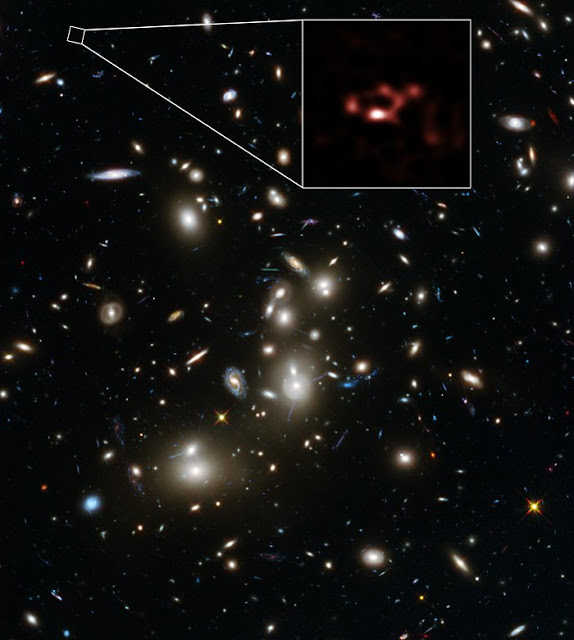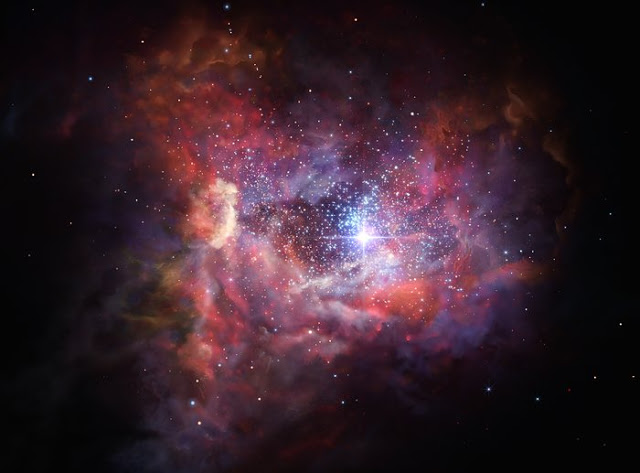

| Online: | |
| Visits: | |
| Stories: |

| Story Views | |
| Now: | |
| Last Hour: | |
| Last 24 Hours: | |
| Total: | |
New Insights into the Birth and Death of the First Stars
Astronomers have used ALMA to detect a huge mass of glowing stardust in a galaxy seen when the Universe was only four percent of its present age. This galaxy was observed shortly after its formation and is the most distant galaxy in which dust has been detected. This observation is also the most distant detection of oxygen in the Universe. These new results provide brand-new insights into the birth and explosive deaths of the very first stars.
An international team of astronomers, led by Nicolas Laporte of University College London, have used the Atacama Large Millimeter/submillimeter Array (ALMA) to observe A2744_YD4, the youngest and most remote galaxy ever seen by ALMA. They were surprised to find that this youthful galaxy contained an abundance of interstellar dust — dust formed by the deaths of an earlier generation of stars.
This artist’s impression shows what the very distant young galaxy A2744_YD4 might look like. Observations using ALMA have shown that this galaxy, seen when the Universe was just 4% of its current age, is rich in dust. Such dust was produced by an earlier generation of stars and these observations provide insights into the birth and explosive deaths of the very first stars in the Universe.
Follow-up observations using the X-shooter instrument on ESO’s Very Large Telescope confirmed the enormous distance to A2744_YD4. The galaxy appears to us as it was when the Universe was only 600 million years old, during the period when the first stars and galaxies were forming [1].
“Not only is A2744_YD4 the most distant galaxy yet observed by ALMA,” comments Nicolas Laporte, “but the detection of so much dust indicates early supernovae must have already polluted this galaxy.”
ALMA observations have revealed that a very distant galaxy, seen when the Universe was just 4% of its current age, was rich in cosmic dust. This ESOcast Light quickly looks at what this means and why it is important.
The observations of the dusty galaxy A2744_YD4 were made possible because this galaxy lies behind a massive galaxy cluster called Abell 2744 [2]. Because of a phenomenon called gravitational lensing, the cluster acted like a giant cosmic “telescope” to magnify the more distant A2744_YD4 by about 1.8 times, allowing the team to peer far back into the early Universe.
This image is dominated by a spectacular view of the rich galaxy cluster Abell 2744 from the NASA/ESA Hubble Space Telescope. But, far beyond this cluster, and seen when the Universe was only about 600 million years old, is a very faint galaxy called A2744_YD4. New observations of this galaxy with ALMA, shown in red, have demonstrated that it is rich in dust.

Credit: ALMA (ESO/NAOJ/NRAO), NASA, ESA, ESO and D. Coe (STScI)/J. Merten (Heidelberg/Bologna)
The ALMA observations also detected the glowing emission of ionised oxygen from A2744_YD4. This is the most distant, and hence earliest, detection of oxygen in the Universe, surpassing another ALMA result from 2016.
The team estimates that A2744_YD4 contained an amount of dust equivalent to 6 million times the mass of our Sun, while the galaxy’s total stellar mass — the mass of all its stars — was 2 billion times the mass of our Sun. The team also measured the rate of star formation in A2744_YD4 and found that stars are forming at a rate of 20 solar masses per year — compared to just one solar mass per year in the Milky Way [3].
This zoom video sequence starts with a flight through the faint constellation of Sculptor (The Sculptor). We soon see a rich group of distant galaxies, the cluster Abell 2744, known as Pandora’s Cluster. But continuing even further back into the early Universe we finish the trip looking at the dusty galaxy A2744_YD4, the most distant galaxy ever seen with ALMA.
Credit: ALMA (ESO/NAOJ/NRAO), NASA, ESA, ESO and D. Coe (STScI)/J. Merten (Heidelberg/Bologna)/spaceengine.org/Digitized Sky Survey 2
“This rate is not unusual for such a distant galaxy, but it does shed light on how quickly the dust in A2744_YD4 formed,” explains Richard Ellis (ESO and University College London), a co-author of the study. “Remarkably, the required time is only about 200 million years — so we are witnessing this galaxy shortly after its formation.”
“With ALMA, the prospects for performing deeper and more extensive observations of similar galaxies at these early times are very promising,” says Ellis.
And Laporte concludes: “Further measurements of this kind offer the exciting prospect of tracing early star formation and the creation of the heavier chemical elements even further back into the early Universe.”
Notes
[1] This time corresponds to a redshift of z=8.38, during the epoch of reionisation.
[2] Abell 2744 is a massive object, lying 3.5 billion light-years away (redshift 0.308), that is thought to be the result of four smaller galaxy clusters colliding. It has been nicknamed Pandora’s Cluster because of the many strange and different phenomena that were unleashed by the huge collision that occurred over a period of about 350 million years. The galaxies only make up five percent of the cluster’s mass, while dark matter makes up seventy-five percent, providing the massive gravitational influence necessary to bend and magnify the light of background galaxies. The remaining twenty percent of the total mass is thought to be in the form of hot gas.
[3] This rate means that the total mass of the stars formed every year is equivalent to 20 times the mass of the Sun.
Source:



